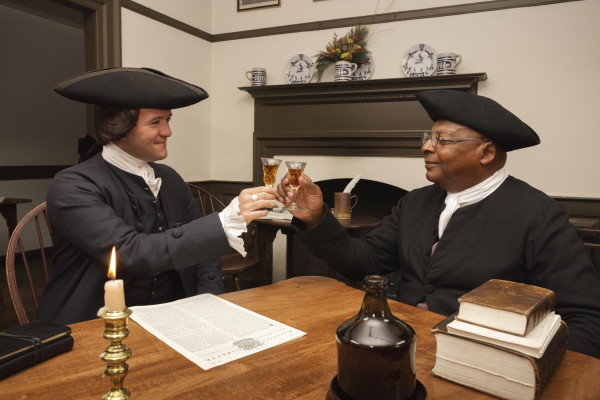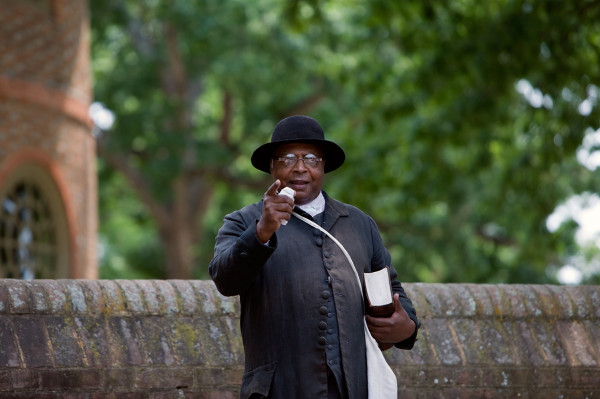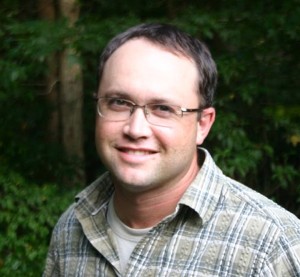Put yourself in an interpreter’s shoes. You’ve buttoned your waistcoat or tied on your petticoat. It’s time to stroll down Duke of Gloucester Street for some friendly banter with modern guests to Colonial Williamsburg’s Historic Area. What do you say? How do you act?
Where have you gotten the background knowledge to pull it off?
Portrayals of the lives of some 18th-century Americans who lived in Williamsburg during the American Revolution often evolve from long hours studying the letters, diaries or account books they left behind. Many such sources survive more than 200 years after people created them.
But what about the Americans whose lives weren’t so well-documented? About half the people living in Williamsburg in the 1770s were enslaved and free African Americans, and relatively few records exist for that sizable segment of the population.
James Ingram, Jr., one of 25 African American interpreters at Colonial Williamsburg, faced that challenge. He “interprets” — or portrays — enslaved Baptist preacher Gowan Pamphlet, an 18th-century Williamsburg resident.
When Ingram began interpreting Pamphlet 15 years ago, he didn’t know of any surviving documents left by Pamphlet himself. That was a hurdle, but not a showstopper.
Just because African Americans in the past didn’t write down much, according to Ingram, doesn’t mean that nothing was written about them. “The documentation is often there, it’s just a matter of researching the people who were around an [African American] individual.”
For instance, Ingram found references to Pamphlet in the records of one Dr. Pasteur, whom Pamphlet visited many times for elixirs to control various ailments. Ingram drew from these notations that Pamphlet was an evangelist who stuck with his call to ministry despite the consequences to his health.

“Illnesses like the ones [Pamphlet] got were common to people who preached outside,” says Ingram. Religious gatherings of free and enslaved African Americans often occurred with little more shelter than a brush arbor and sometimes without even that meager protection against the elements.
Still, historians must take care when considering old sources, according to Stephen Seals, Colonial Williamsburg’s manager of program development for African American and religion interpretation. Using secondhand observers to animate people who lived more than two centuries ago, particularly African Americans, presents its own problems.
Seals notes that 18th-century African Americans, both enslaved and free, often employed the technique of “masking,” or hiding their true emotions while in public. Masking was one means of survival in a segregated society that was weighted so heavily against them.
“Usually the other people writing about African Americans don’t know them and aren’t part of their trusted circle,” says Seals. “You have to look at who is saying this and why they are saying it.”
For instance, enslaved people sometimes sang together as they carried on with their daily labor. One contemporary witness might write of their apparent content. But their genuine intent—conveying the best time for one among them to attempt an escape—would likely pass unrecorded.
“If you want to understand why these people acted the way they did, you have to look at the larger context and consider everything that was going on in their lives,” says Seals.
Even with the best-documented individuals, large gaps exist in efforts to flesh them out with as much accuracy as possible. Because of that, many of the African American characters that guests meet in the Revolutionary City are a composite of what’s known about several different people.
And where the historical record is still insufficient to illuminate the lives of 18th-century Americans, sometimes the best an interpreter can do is offer an educated guess.

One fact about Pamphlet tugged at Ingram as his interpretation developed: there’s no evidence that Pamphlet ever married or had children, even though he often performed “jumping the broom” wedding ceremonies for other African Americans around Williamsburg in lieu of legal marriages. It could have been that Pamphlet’s preaching, not to mention his duties at King’s Arms Tavern, where he lived and worked for his owner, left little time for a family.
But Ingram says there could have been other reasons for Pamphlet’s bachelorhood that aren’t apparent with a cursory glance at his life. Estate sales occurred at King’s Arms Tavern, for example, and Pamphlet likely saw them often. “He would have witnessed many families torn apart right there,” says Ingram. “That’s an image you can’t forget, a wound you carry forever.”
Want to learn more about the challenges of researching and interpreting African Americans in the 18th century? Check out this Past & Present podcast on African American religions with historian Harvey Bakari and this blog post by archaeologist Ywone Edwards-Ingram.
There’s also a wealth of information on the people of Williamsburg.
 Ben Swenson lives in Williamsburg, Virginia with his wife and two sons. His writing career has led him to all sorts of odd corners of the world: he has jumped out of a perfectly good airplane, wrestled crab pots on a Chesapeake Bay work boat and taken a helicopter ride through a twisting river gorge. Odds are good you will find him outside with them somewhere when he is not chasing or telling stories.
Ben Swenson lives in Williamsburg, Virginia with his wife and two sons. His writing career has led him to all sorts of odd corners of the world: he has jumped out of a perfectly good airplane, wrestled crab pots on a Chesapeake Bay work boat and taken a helicopter ride through a twisting river gorge. Odds are good you will find him outside with them somewhere when he is not chasing or telling stories.

Leave a Reply